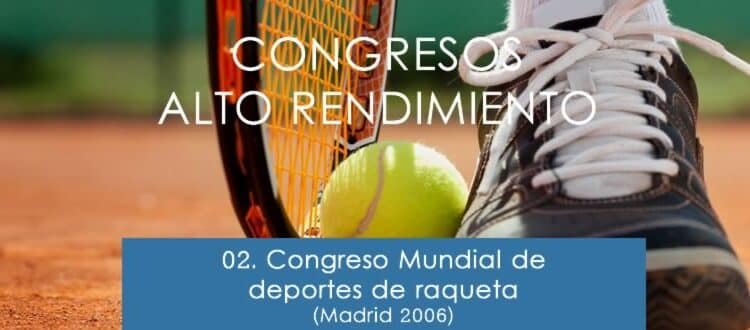Core temperature and hydration status in professional tennis players measured in live tournament conditions.
Resumen
Tennis is a sport in which intermittent and explosive bouts of anaerobic activity are interspersed with periods of rest. The unpredictability of the performance demands of tennis means that typical rallies (not including aces) can range between 3s to over 20s depending on aspects such as: the standard of player (Richers, 1995; Bernardi et al., 1998); type of playing style, for example, serve/volley vs. baseline (Hughes and More, 1998; Bernardi et al., 1998); and the playing surface (Hughes and Clark, 1995). Match lengths can range anywhere between less than one hour in best of three set matches, to more than five hours in five set matches (Christmass et al., 1998). Reviews by Kovacs (2006) and Fernandez et al. (2006) present a comprehensive overview of the physiological demands of tennis. In addition to the physically demanding aspects of tennis another major challenge which presents to players is the external environment. Heat and potential dehydration in particular present major obstacles to performance (Marks et al, 2004). Dawson et al. (1985) observed that professional tennis players, competing in-year round tournament calendars, participate in a wide variety of climatic conditions from cool and dry conditions to hot and/or humid conditions. For many players, life on the professional circuit is tough. Unlike major tournaments, such as the Grand Slams, where players may have a day between to recover between their matches (if they are only playing singles), for players participating in lower level events run by the International Tennis Federation, in conjunction with the Womens Tennis Association (WTA) and the Association of Tennis Professions (ATP) such as Satellite, Challenger and Futures events, it is not uncommon for players to be playing on a daily basis, and in some cases where timing issues arise, play two matches a day. For these players, issues of heat adaptation and hydration practices are important. The ITF and a number of National Tennis Federations have adopted heat policies whereby play will be suspended (in some policies matches currently in progress) when the dry bulb globe temperature (ambient temperature) and wet bulb globe temperature reach a particular limit (policies have slight variations of each other). These heat policies have been developed from generic sports medicine and military research data (Sparling and Millard-Stafford, 1999; Bricknell, 1996). Given these heat policies are based on generic data, and with IV Congreso Mundial de Ciencia y Deportes de Raqueta recent anecdotal cases of players suffering from heat stress during professional tournament play, the need to develop tennis-specific guidelines has been raised by the ITF Medical Commission. To date, specific tennis thermoregulation and hydration practices research has only been conducted under simulated tennis conditions (Dawson et al., 1985; Bergeron et al., 1991; Kavasis, 1995; Therminorias et al., 1995; McCarthy et al, 1998). Therefore the purpose of this study was to examine core temperature responses and hydration status measured in professional touring players during live tournament conditions.
1. INTRODUCTION
Tennis is a sport in which intermittent and explosive bouts of anaerobic activity are interspersed with periods of rest. The unpredictability of the performance demands of tennis means that typical rallies (not including aces) can range between 3s to over 20s depending on aspects such as: the standard of player (Richers, 1995; Bernardi et al., 1998); type of playing style, for example, serve/volley vs. baseline (Hughes and More, 1998; Bernardi et al., 1998); and the playing surface (Hughes and Clark, 1995). Match lengths can range anywhere between less than one hour in best of three set matches, to more than five hours in five set matches (Christmass et al., 1998). Reviews by Kovacs (2006) and Fernandez et al. (2006) present a comprehensive overview of the physiological demands of tennis. In addition to the physically demanding aspects of tennis another major challenge which presents to players is the external environment. Heat and potential dehydration in particular present major obstacles to performance (Marks et al, 2004). Dawson et al. (1985) observed that professional tennis players, competing in-year round tournament calendars, participate in a wide variety of climatic conditions from cool and dry conditions to hot and/or humid conditions. For many players, life on the professional circuit is tough. Unlike major tournaments, such as the Grand Slams, where players may have a day between to recover between their matches (if they are only playing singles), for players participating in lower level events run by the International Tennis Federation, in conjunction with the Womens Tennis Association (WTA) and the Association of Tennis Professions (ATP) such as Satellite, Challenger and Futures events, it is not uncommon for players to be playing on a daily basis, and in some cases where timing issues arise, play two matches a day. For these players, issues of heat adaptation and hydration practices are important. The ITF and a number of National Tennis Federations have adopted heat policies whereby play will be suspended (in some policies matches currently in progress) when the dry bulb globe temperature (ambient temperature) and wet bulb globe temperature reach a particular limit (policies have slight variations of each other). These heat policies have been developed from generic sports medicine and military research data (Sparling and Millard-Stafford, 1999; Bricknell, 1996). Given these heat policies are based on generic data, and with recent anecdotal cases of players suffering from heat stress during professional tournament play, the need to develop tennis-specific guidelines has been raised by the ITF Medical Commission. To date, specific tennis thermoregulation and hydration practices research has only been conducted under simulated tennis conditions (Dawson et al., 1985; Bergeron et al., 1991; Kavasis, 1995; Therminorias et al., 1995; McCarthy et al, 1998). Therefore the purpose of this study was to examine core temperature responses and hydration status measured in professional touring players during live tournament conditions.
2. METHODS, SUBJECTS AND MATERIALS
All professional tennis players who entered sanctioned ITF and Tennis Australia professional tournaments in South Australia and Victoria, Australia, in 2004 and 2005 were invited to participate in the study. Eleven players (three male, eight female; aged between 19 and 30 years of age) participated in the testing procedures. All methods, conforming to the Code of Ethics of the World Medical Association (Declaration of Helsinki), were approved by Victoria University Human Ethics Committee (HRETH.FHD.108/04) and the International Tennis Federation (ITF) Medical Commission. Data was collected over three tournaments played on hard courts in 2004 and 2005 where players volunteered for the study. Measurement of environmental conditions, ambient temperature as measured by dry globe bulb temperature (DBGT), relative humidity (RH) and wet bulb globe temperature (WBGT), were conducted using an environmental measurement monitor (Kestrel 3000, Nielsen-Kellerman, USA). For regional tournaments where continuous on-court measurements were not taken, measurements were obtained from the Melbourne and Adelaide Bureaus of Meteorology at the weather station closest to the tournament site. Hydration status was measured using a hand-held refractometer (Atago Co., Japan). This presented a measure of the urine specific gravity (grams/ml). Players were given a plastic sterile urine collection bottle and asked to provide a “clean-catch” (mid-stream) sample. Samples were obtained pre- and post-match. Player’s body mass at pre- and post-match were measured to the nearest 100g using scales which were calibrated daily during the events. Player’s internal core temperature was measured subsequent to daily breakfast ingestion of a CorTempTM core body temperature sensor pill (Figure 1; HQ Inc, USA). The sensor pill transmitted the player’s core temperature and measured by CorTempTM wireless telemetry system (Figure 2a and 2b; HQ Inc, USA) during 90-second change of ends when players were seated. The measure of progressive core temperature was taken without disturbing the players during their rest time (Figure 2b).
Figure 1. CorTempTM core body temperature sensor pill.
Figure 2a (left). CorTempTM core body temperature wireless monitoring system;
Figure 2b (right) measurement of a player in-match during change of ends.
Due to small numbers of subjects participating in the study, descriptive statistics will be presented. Group data is presented in means and standard deviations.
3. RESULTS
The time duration of matches recorded during the tournaments ranged from 50mins to 160mins. No players experienced any form of heat illness during the tournaments nor adverse affects from swallowing the temperature sensor. Of the 11 participating players, five progressed past the first round, with three players participating in three or more consecutive rounds. 3.1 ENVIRONMENTAL CONDITIONS Table 1 presents the environmental conditions obtained from the various tournaments during time of play. On-court ambient temperature DBGT recorded during all tournaments ranged between 17 to 38oC and WBGT ranged from 10.8 to 29.0oC. Only one of the days saw ambient temperature exceed 35°C. RH ranged between 14 to 93%.
Table 1. Environmental conditions during times of play.
3.2 HYDRATION STATUS – URINE SPECIFIC GRAVITY AND BODY MASS. Pre-match hydration measures ranged between 1.003 to 1.024 grams/ml (mean 1.014 ± 0.008 grams/ml) with post-match measures ranging between 1.004 to 1.025 grams/ml (mean 1.012 ± 0.010 grams/ml). Table 2 presents individual pre and post match hydration levels. In five of the matches players presented with decreased hydration status post-match (range 0.004 to 0.013 grams/ml), however in four matches players presented with an increased hydration status post-match (range 0.005 to 0.017 grams/ml). Three matches showed no change in hydration status.
Table 2. Hydration status as measured by specific gravity (grams/ml). N/A refers to players unable to provide a urine sample.
The change in body mass between pre- and post-match ranged from 2.9% deficit to 2.0% increase pre and post match (mean 0.09 ± 1.28% deficit). Analysis of individual matches showed that in five matches, players lost weight (range 0.27% to 2.9% of body weight), eight matches players showed increased weight post-match (range 0.15% to 2%), and two matches no change was observed.
Table 3. Hydration status as measured by changes in athlete body weight (kg). A negative number represents a loss in body weight; a positive number represents a gain in body weight.
3.3 CORE TEMPERATURE MEASURES – INDIVIDUAL MATCH RESULTS All players experienced an increase in core temperature during the match ranging between 0.1 to 2.3oC (Table 4). Individual match analysis did not show any association between the ambient temperature and a player’s mean core temperature (Figure 3).
Table 4. Core temperature at match start, peak and mean core temperature during player’s first match across three tournaments.
Figure 3. Mean core temperature correlated to ambient temperature (r = -0.28).
3.3.1 CORE TEMPERATURE MEASURES – MULTIPLE MATCH RESULTS Four of the five players showed an overall trend of increased mean core temperature in preceding day’s matches (Table 5). Of the nine matches where core temperature was taken, seven showed an increase in mean core temperature compared to the previous day’s match.
Table 5. Mean core temperature responses in five players who progressed past the first round.
4. DISCUSSION
This study is the first to present core temperature and hydration status data from professional tennis players under live competitive tournament playing conditions. The results presented suggest that despite inadequate pre-match and during-match hydration status in some players, players involved in “singular” matches (where players are playing in their first match and/or only play one round) did not present with extremely elevated core body temperatures. However, players who progressed through several rounds showed an increased mean core temperature compared to their previous match (in all but two matches) notwithstanding on-court environmental conditions. All players who participated in the study were provided with a personalized report of their hydration status and core temperature results from the match(s) played. Follow up education and discussion for any players and their coach with regards to the results were available from the investigator during the tournament and post-tournament via email. Given the nature of professional tennis tournaments where players are not fully aware of when they are playing (organizers schedule matches in order of play on each court rather than to time) standardization issues such as providing a urine sample, and the ingestion of the temperature sensor contributed to missed data points. Further, several athletes who initially volunteered for the study withdrew prior to the tournament or in the initial stages of their first match due to injury. Simulated tennis studies (Dawson et al, 1985; Bergeron et al, 1995; McCarthy et al, 1998) have shown decreases in body weight suggesting dehydration. However, in this study an increase in body mass and improvement in hydration status in a number of players was observed. Four players started their matches in a dehydrated state, defined by Stuempfle and Drury (2003) as urine specific gravity >1.020, and hydrating during changeovers in the match. Despite numerous articles on athlete hydration in the coaching and sports science literature (Armstrong, 2006; Groppel, 2002; and Mannie, 2004), eight of the eleven participating players in the study admitted anecdotally they were unaware of their hydration status or admitted they did not properly prepare. Core temperature results from single and/or first round matches were similar (or slightly lower) to those reported by Dawson et al. (1985), and Therminarias et al. (1994) being 38.4oC in college level and intermediate level players respectively. However, the trend of increasing mean core temperatures in players (group mean increase of 0.7%; range -1.6% to 4%) in proceeding matches needs to be further explored as only small numbers of players in this study made it through several rounds. Further study and data collection of players’ core temperature and hydration status needs to be conducted under live tournament conditions where valuable ranking points and prize money are on the line. More importantly research must continue with a view to obtaining thermoregulatory data on days of extreme and stressful heat as the current study was limited in the actual temperature range in which data were collected. This will allow for meaningful and specific evidence-based data to assist the ITF, WTA/ATP and tennis federation’s in determining and regulating player heat stress, and the development of appropriate and tennis-specific heat policies.
Bibliografía
- Armstrong L.E. 2006. “Nutritional strategies for football: counteracting head, cold, high altitude and jet lag.” Journal of Sports Sciences. 24, 723-741.
- Bergeron M.F., Armstrong L.E., Maresh C.M. 1995. “Fluid and electrolyte losses during tennis in the heat.” Clinics in Sports Medicine. 14, 23-32.
- Bergeron M.F., Maresh C.M., Kraemer W.J., Abraham A., Conroy B., Gabaree C. 1991. “Tennis: a physiological profile during match play.” International Journal of Sports Medicine. 12, 474-479.
- Bernardi M., De Vito G., Falvo M.E., Marino S., and Montellanico F. (1998). “Cardiorespiratory adjustment in middle-level tennis players: Are long term cardiovascular adjustments possible?” In: Science and Racket Sports II (edited by A. Lees, I. W. Maynard, M Hughes, T Reilly), London: E & FN Spon.
- Bricknell M. 1996. “Heat illness in the army in Cyprus.” Occupational Medicine, 46, 304-12
- Christmass MA, Richmond SE, Cable NT, et al. Exercise intensity and metabolic response in singles tennis. J Sport Sci 1998;16:739-47.
- Dawson B., Elliott B.C., Pyke F.and Rogers R 1985. “Physiological and performance responses to playing tennis in a cool environment and similar intervalised treadmill running in a hot climate.” Journal of Human Movement Studies, 11, 21-34.
- Fernandez J., Mendez-VillanuevaA ., and Pluim B.M. 2006.”Intensity of tennis match play.” British Journal of Sports Medicine. 40, 387-391.
- Groppel J. 2002. “Heating up – plan for play in extreme conditions.” ADDvantage. 26, 6-7.
- Hughes M., and Clarke S. 1995. “Surface effect on elite tennis strategy.” In: Science and Racket Sports (edited by T Reilly, M Hughes, A. Lees), London: E & FN Spon.
- Hughes M., and Moore P. 1998. “Movement analysis of elite level male ‘serve and volley’ tennis players.” In: Science and Racket Sports II (edited by A. Lees, I. W. Maynard, M Hughes, T Reilly), London: E & FN Spon.
- Kavasis K. 1995. “Fluid replacement needs of young tennis players.” In: Science and Racket Sports (edited by T Reilly, M Hughes, A. Lees), London: E & FN Spon.
- Kovacs M.S. 2006. “Applied physiology of tennis performance.” British Journal of Sports Medicine. 40, 381-386.
- Mannie K. 2004. “Tip from the trenches.” Coach and Athletic Director. 74, 12
- Marks B.L., Angelopoulos T.J., Shields E., Katz L.M., Moore T., Hylton S., Larson R.and Wingo J 2004. “The effects of a new sports drink on fatigue factors in competitive tennis athletes.” In: Science and Racket Sports III (edited by A. Lees, J.-F. Kahn and I. W. Maynard), London: Routledge.
- McCarthy P.R., Thorpe R.D., and Williams C. (1998). “Body fluid loss during competitive tennis match-play.” In: Science and Racket Sports II (edited by A. Lees, I. W. Maynard, M Hughes, T Reilly), London: E & FN Spon.
- Richers, T.A. (1995). “Time-motion analysis of the energy systems in elite and competitive singles tennis.” Journal of Human Movement Studies, 28, 73-86.
- Sparling P.B., and Millard-Stafford M.L. 1999. “Keeping sports participants safe in hot weather.” Physician and Sports Medicine. 27, 9
- Stuempfle, K.J., and Drury D.G. 2003. “Comparison of 3 methods to assess urine specific gravity in collegiate wrestlers.” Journal of Athletic Training. 38, 315-319.
- Therminarias A., Dansou P., Chirpz M.F., Eterradossi J., and Favre-Juvin A. 1995. “Cramps, heat stroke and abnormal biological responses during a strenuous tennis match.” In: Science and Racket Sports (edited by T Reilly, M Hughes, A. Lees), London: E & FN Spon.















